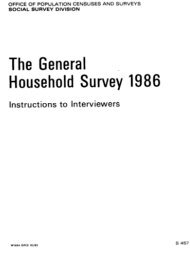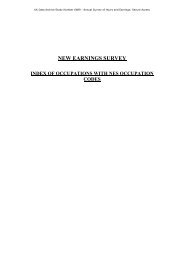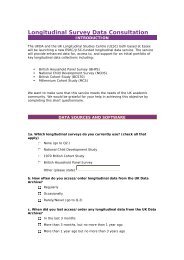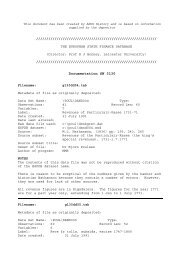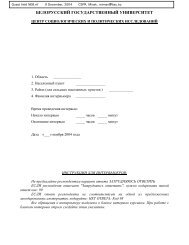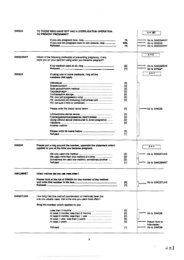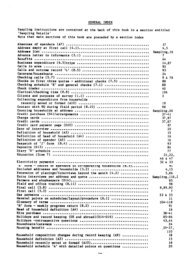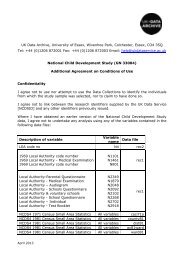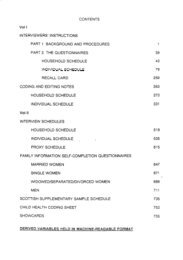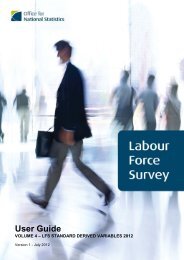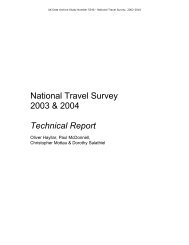c' G - Economic and Social Data Service (ESDS)
c' G - Economic and Social Data Service (ESDS)
c' G - Economic and Social Data Service (ESDS)
Create successful ePaper yourself
Turn your PDF publications into a flip-book with our unique Google optimized e-Paper software.
2. Accuracy of information<br />
Interviewers are attempting to collect accurate information. Similarly PAB wil1<br />
code only that information which seams to ba the most accurate end reliable. To<br />
achieve this us need to examine @s 4-8 (also @s. 2 <strong>and</strong> 3) as .swhole. Certain<br />
conditions will be applied <strong>and</strong> on this basis the answers at @s. 4-0 will be<br />
accepted or rejected.<br />
3. Pey Slip Code<br />
To provide us with a means of determining the accuracy of information given at<br />
QIIS. 4-8, we need to check the coding at the pay slip code.<br />
a. Consulted for correct date<br />
‘lMs means that the pay slip was consulted for the date that the informant<br />
was last paid ie the date at Qn. 1.<br />
b. Consulted for a different date<br />
‘fhismeans that the pay slip consulted was an old one up to three calendar<br />
months ago <strong>and</strong> was used to estimate last times pay, eg by adding on any<br />
increases that have occurred since the date of the old pay slip.<br />
c. If a pay slip more than three calendar months ago was available, it should<br />
not have been consulted unless the informant is certain that no charge has<br />
~urred since that time, in which case they are treated as ‘Different<br />
Date’ .<br />
4. More detailed instructions, specific to each of questions 4 - 8 follow, but the<br />
general principle of coding Qns. 4-8 is:<br />
—<br />
1. Deductions will only be coded where the correct/acceptable pay slip was<br />
seen <strong>and</strong> there are no omissions. Therefora points 2 <strong>and</strong> 3 below only<br />
apply where the appropriate pay slip was seen <strong>and</strong> there are no omissions.<br />
2. where deductions from earnings are not given in full only take home pay<br />
<strong>and</strong> gross earnings will be accepted~d coded.<br />
3. Where deductions are given in full a check will be made to establish<br />
—<br />
whether take home pay plus deductions equals the gross earnings.<br />
a. If they do or there is an acceptable discrepancy all figures will<br />
be accepted <strong>and</strong> coded. ~ acceptable discrepancy between the gross<br />
pay <strong>and</strong> the total of the take home pay plus deductions is one which<br />
is up to <strong>and</strong> including 5% of the take home pay. ieif T+ D#G,<br />
<strong>and</strong> the discrepancy is up to <strong>and</strong> including 59 of T the figures at<br />
@s. 4-8 are accepted <strong>and</strong> coded.<br />
If the take hmns pay plus deductions equal the gross pay, the<br />
figures at @s. 4-8 are accepted <strong>and</strong> coded.<br />
b. If they do not <strong>and</strong> there is an unacceptable discrepancy the figures<br />
for take home pay will be accepted <strong>and</strong> coded. The gross earnings<br />
will bs the sum of the take home pay plus deductions, therefore the<br />
original gross figure must be amended <strong>and</strong> the deductions deleted.<br />
w unacceptable discrepancy is~ ~ch take home Py plus<br />
deductions do not equal gross pay <strong>and</strong> the discrepancy is more than<br />
59 of the take home pay.<br />
-6-



